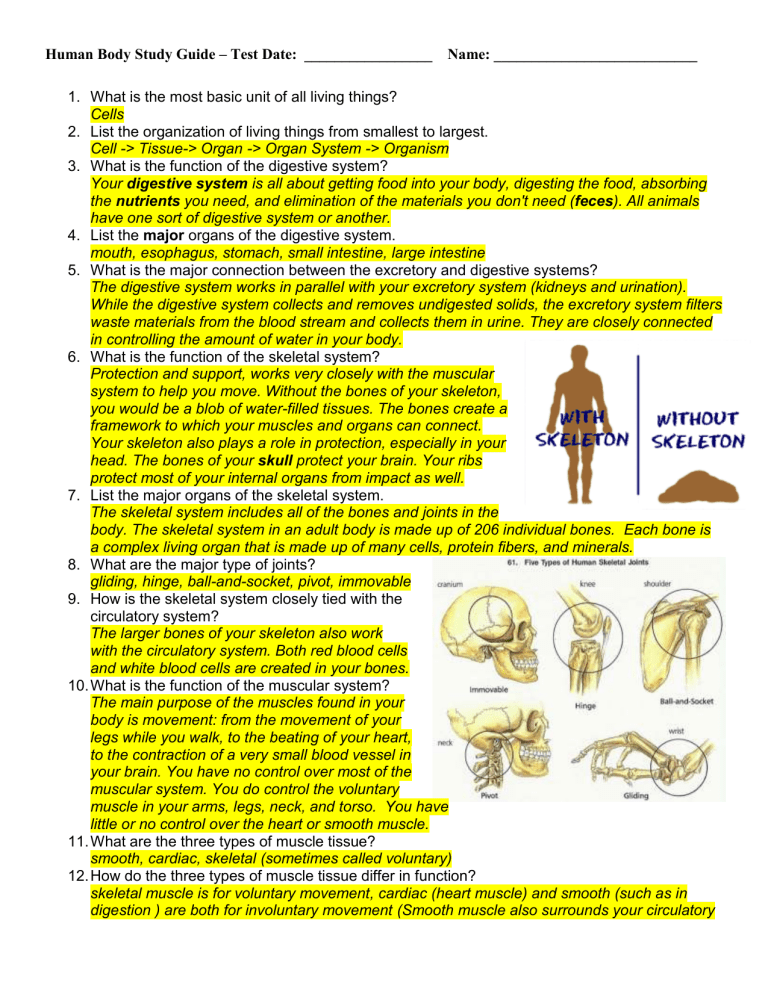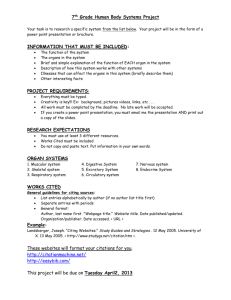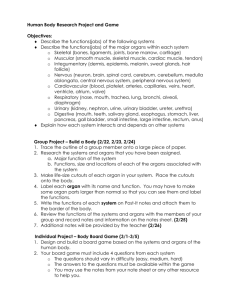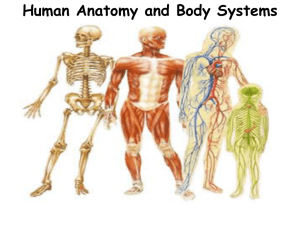Unit 4 (Human Body) Study Guide

Human Body Study Guide – Test Date: _________________ Name: ___________________________
1. What is the most basic unit of all living things?
Cells
2. List the organization of living things from smallest to largest.
Cell -> Tissue-> Organ -> Organ System -> Organism
3. What is the function of the digestive system?
Your digestive system is all about getting food into your body, digesting the food, absorbing the nutrients you need, and elimination of the materials you don't need (feces). All animals have one sort of digestive system or another.
4. List the major organs of the digestive system. mouth, esophagus, stomach, small intestine, large intestine
5. What is the major connection between the excretory and digestive systems?
The digestive system works in parallel with your excretory system (kidneys and urination).
While the digestive system collects and removes undigested solids, the excretory system filters waste materials from the blood stream and collects them in urine. They are closely connected in controlling the amount of water in your body.
6. What is the function of the skeletal system?
Protection and support, works very closely with the muscular system to help you move. Without the bones of your skeleton, you would be a blob of water-filled tissues. The bones create a framework to which your muscles and organs can connect.
Your skeleton also plays a role in protection, especially in your head. The bones of your skull protect your brain. Your ribs protect most of your internal organs from impact as well.
7. List the major organs of the skeletal system.
The skeletal system includes all of the bones and joints in the body. The skeletal system in an adult body is made up of 206 individual bones. Each bone is a complex living organ that is made up of many cells, protein fibers, and minerals.
8. What are the major type of joints? gliding, hinge, ball-and-socket, pivot, immovable
9. How is the skeletal system closely tied with the circulatory system?
The larger bones of your skeleton also work with the circulatory system. Both red blood cells and white blood cells are created in your bones.
10. What is the function of the muscular system?
The main purpose of the muscles found in your body is movement: from the movement of your legs while you walk, to the beating of your heart, to the contraction of a very small blood vessel in your brain. You have no control over most of the muscular system. You do control the voluntary muscle in your arms, legs, neck, and torso. You have little or no control over the heart or smooth muscle.
11. What are the three types of muscle tissue? smooth, cardiac, skeletal (sometimes called voluntary)
12. How do the three types of muscle tissue differ in function? skeletal muscle is for voluntary movement, cardiac (heart muscle) and smooth (such as in digestion ) are both for involuntary movement (Smooth muscle also surrounds your circulatory
and lymph system - those muscle tissues are spread throughout your body and are even involved in controlling the temperature of your body)
13. What is the relationship between the muscular and skeletal system? muscles connect to your skeleton and they contract and move the skeleton along
14. What is the function of the immune system? it protects the cells of your body from bacteria, viruses, and poisons you might encounter every day, it can attack foreign invaders or it can go after cells created within your body that could endanger your life (such as cancer cells)
15. What are the main parts of the immune system? lymphoid organs: adenoids, appendix, bone marrow, lymph nodes and lymphatic vessels, spleen, thymus, tonsils
16. Why is the integumentary system important to the immune system? your skin is usually the first defense your body has against disease (there is far more chance you will get dangerous bacteria or viruses on your skin and hands than breathe those microorganisms in your lungs), you have cells and compounds on your skin that help to kill any bacteria that appear
17. What is the function of the circulatory/cardiovascular system? transportation system for your body: carries chemicals and gases (dissolved gases such as oxygen) to all points in your body and waste products away (including carbon dioxide) – this delivery system gets material to and from all of the cells in your body
18. What are the major parts of the circulatory/cardiovascular system? the heart and a system of vessels including veins, arteries, and capillaries
19. Within what system are red blood cells produced? skeletal: red and white blood cells are produced in your larger bones
{white blood cells are produced inside the bone marrow and stored in your blood and lymphatic tissues; some white blood cells have a short lifespan of one to three days, your bone marrow is constantly producing them}
{red blood cells are made inside your bones, in the bone marrow; they typically live for about 120 days, and then they die }
20. What is the function of the respiratory system?
Your respiratory system is all about exchanging gases with the environment - its purpose is to bring oxygen into your body. One of the products of cellular respiration is carbon dioxide (it is a waste product for your body). Your respiratory system also helps your body get rid of that carbon dioxide.
21. List the major organs of the respiratory system. nose and mouth, a tube called the pharynx, another tube called the trachea, and your lungs
22. How are the circulatory and respiratory system interdependent? exchange of gases between the circulatory and respiratory systems happens in the lungs
23. What is the function of the endocrine system? this system is a complex network of glands and organs that uses hormones to control and coordinate your body's internal metabolism (or homeostasis), energy level, reproduction, growth and development, and response to injury, stress, and environmental factors
24. What are the major parts of the endocrine system?
Hypothalamus, thymus, thyroid, parathyroid, adrenal gland, pancreas, kidney, testis, ovary
25. Explain why the endocrine system is important for maintaining homeostasis? it controls and coordinate your body's internal metabolism (or homeostasis), energy level, reproduction, growth and development, and response to injury, stress, and environmental factors
26. What is the function of the nervous system? responsible for the control of the body and communication among its parts, receives and sends information throughout the body
27. List the two major types of nervous systems. central nervous system (CNS) and peripheral nervous system (PNS)- humans have both that work together to form our nervous system
28. What are the main parts of the nervous system? brain and spinal cord (CNS), sensory nerves and sense organs (PNS)
29. What is the function of the excretory system? filters and eliminates wastes from the body, also maintains the homeostasis of water, ions, pH, blood pressure, calcium, and red blood cells.
30. List the major organs of the excretory system. kidneys, two ureters, the bladder, and the urethra
31. What is the function of the integumentary system? protects your body from disease by providing a barrier to viruses and bacteria, protects your body from physical damage by offering a thick barrier that both contains your internal organs and stops large objects from entering your body, protects your body from dehydration, overheating, or freezing, the layer of skin can sweat and help your body cool or surround a layer of fat that keeps warmer temperatures inside.
32. List the major parts of the integumentary system (what are the layers?). skin, hair, fingernails, oil, and sweat glands, they are found in layers called the epidermis (top), dermis, {and subcutaneous (bottom)}









